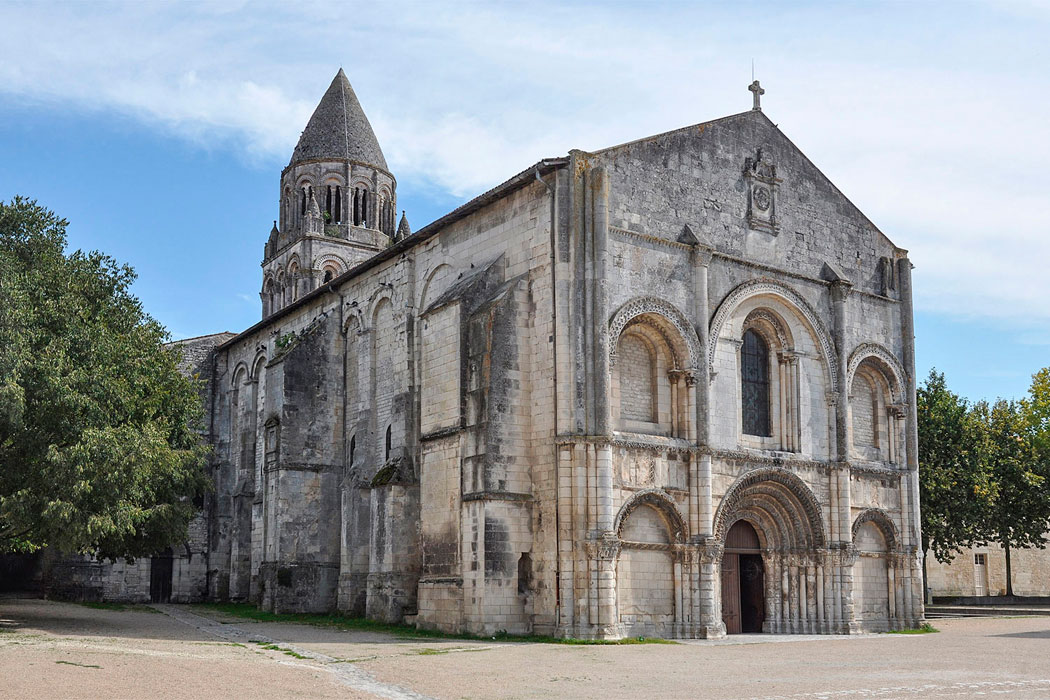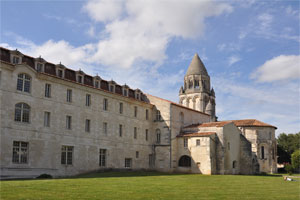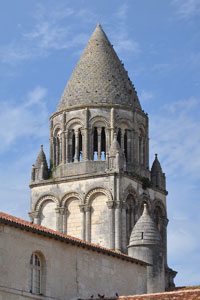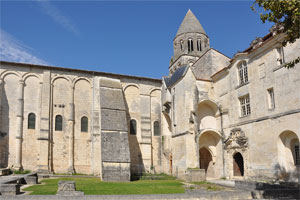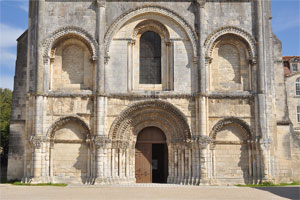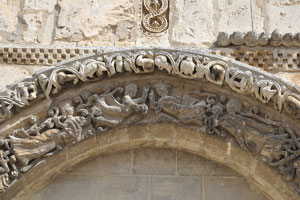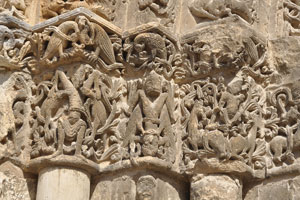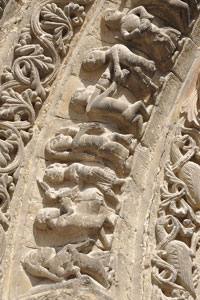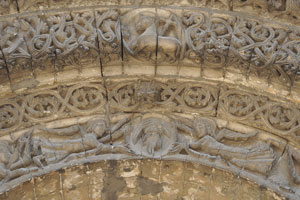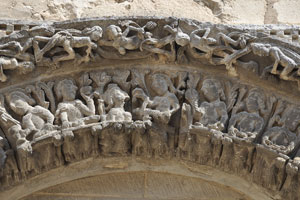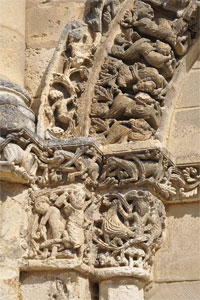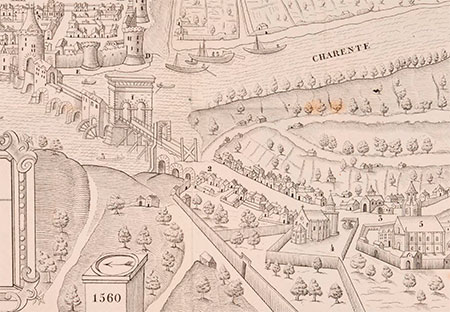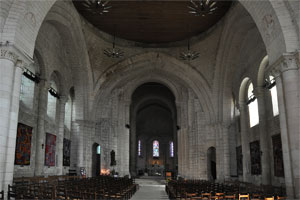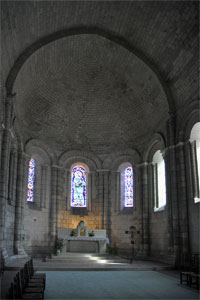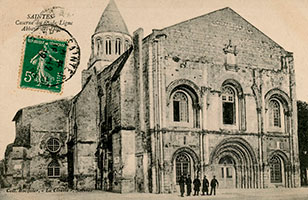Abbey of Sainte-Marie-aux-Dames of Saintes
Abbaye-aux-Dames de Saintes / Saint-Pallais / S Maria Santonen / S Maria Sanctonas
(Saintes, Charente-Maritime)
The women’s monastery of Sainte-Marie-aux-Dames was founded in 1047 by the counts of Anjou, Geoffrey II Martel (c. 1006–1060) and his wife Agnes of Burgundy († 1068), who had previously taken part in the foundation of the Abbey of La Trinité de Vendôme (Loir-et-Cher). The Benedictine nunnery was established outside the town of Saintes, on the opposite bank of the Charente River, in a site inhabited since ancient times and connected to the city by a Roman road and bridge.
The foundation was close to the burial place of Saint Palladius, bishop of Saintes, where a first monastery (Saint-Pallais) had been established at the end of the 6th century. That house was lost due to the Norman invasions and was later held by lay hands. The church of “Sancta Maria Rotunda” is also mentioned in this area. When the new Benedictine monastery was founded, it was richly endowed with lands and rights, including the prerogative to mint coins, as well as several churches, such as that of the former Saint-Pallais monastery and its territory, close to the new establishment.
A large Romanesque church was built and consecrated in 1047, which is still preserved today, although with later modifications. The first abbess of the Benedictine community was Constance (1047–c. 1066). Probably in 1049, a papal bull issued by Pope Leo IX confirmed the foundation, and throughout the 12th century other popes issued documents related to the monastery. Similarly, the dukes of Aquitaine, the counts of Poitou and various monarchs granted privileges and protection, turning the abbey into a prominent centre of influence.
In 1242, following the Battle of Taillebourg, the town of Saintes became a frontier zone facing the English-controlled territories. Later, in 1327, the monastery was affected by the Hundred Years’ War, though the consequences were relatively moderate compared to other sites in the region. In the mid-14th century, it also suffered an outbreak of plague. After these events, the house was restored. In the 16th century, the Wars of Religion brought further damage, especially in 1568, when the abbey was again attacked.
What the wars had not destroyed was caused by two fires in the early 17th century, in 1608 and 1648, which forced the reconstruction of a large part of the monastic buildings. After a period of decline, monastic life came to an end in 1792 as a result of the Revolution. Once abandoned by the nuns, the site was partially destroyed and used as a prison and barracks. During the 20th century, the complex was gradually restored; the church resumed worship in 1942, and today the monastery hosts cultural activities related to music.
Among the surviving structures, the medieval church stands out, preserving elements of the original 11th-century building, though modified between the 12th and 15th centuries. It is a single-nave church with transept and semicircular apse, topped with two domes. The façade, built during the second quarter of the 12th century, is notable for its sculptural decoration, despite the damage caused by the Huguenots and later 20th-century restorations. The decoration is arranged in two levels, each with three arches, with the central portal as the focal point of the lower tier.
- BEAUNIER, Dom (1910). Abbayes et prieurés de l'ancienne France. Vol. 3: Auch, Bordeaux. Abbaye de Ligugé
- BOUDET, Joeph-Marie (1884). Histoire de l'abbaye de Notre-Dame hors les murs de la ville de Saintes (1047-1791). Archives historiques de la Saintonge et de l'Aunis, vol. XII
- BRIAND, Joseph (1843). Histoire de l'église santone et aunisienne, depuis son origine jusqu'à nos jours, vol. 1. La Rochelle: Boutet
- CROZET, René (1956). L’abbaye-aux-Dames de Saintes. Congrès archéologique de France, 114 ss. Société française d'archéologie
- EYGUN, François (1979). Saintogne romane. La nuit des temps, 33. Zodiaque
- GENSBEITEL, Christian; coord. (2009). L’Abbaye aux Dames de Saintes. París: Le Croit vif
- GENSBEITEL, Christian (2020). Saintes, l’Abbaye-aux-Dames. Charente-Maritime. Monastères en Santonge. Congrès Archéologique de France, 177e session. París: Société Française d’Archéologie
- GRASILIER, Pierre; ed. (1871). Cartulaires inédits de la Saintonge, vol. 2. L’abbaye royale de Notre-Dame de Saintes. Niort: Clouzot
- RHEIN, André (1913). Saintes. Congrès archéologique de France, 79 ss. Société Française d’Archéologie
- SAINT-MAUR, Congregació de (1720). Gallia Christiana in provincias ecclesiasticas distributa. Vol. 2. París: Typographia Regia
- SAMSON, Jules (2001). Abbaye aux Dames. IX siècles d’histoire. Saintes: Abbaye aux Dames
- TISSOT, Allan (2012). Une abbaye de renom à l’époque moderne : l’Abbaye aux Dames de Saintes (fin du XVe siècle - début XIXe siècle). Tesi. Université Michel de Montaigne - Bordeaux III
- TONNELLIER, Chanoine (1970). L'architecte Béranger d'après son épitaphe à l'abbaye des Dames de Saintes. Bulletin de la Société des antiquaires de l'Ouest, vol. X. Poitiers
- TREFFORT, Cécile (2023). La mémoire des morts dans une abbaye féminine au Moyen Âge, le cas de l’Abbaye-aux-Dames de Saintes. Espaces monastiques au féminin. Marion Charlet
